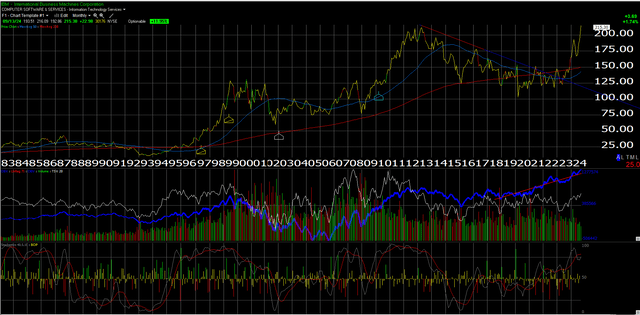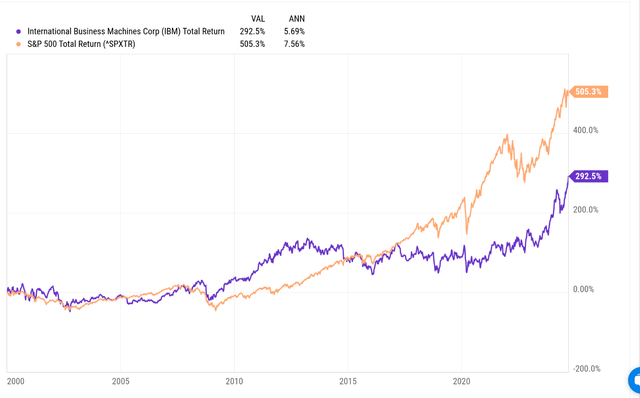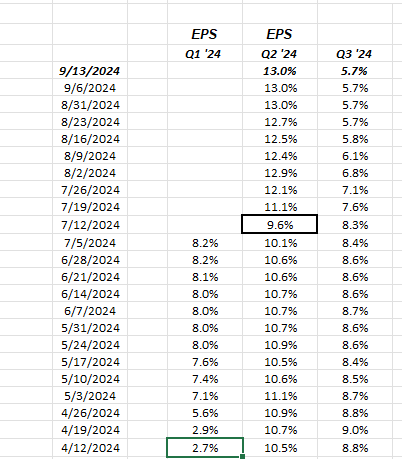
You have to pull up the monthly chart of IBM (IBM) to see the series of all-time highs put in place in April 2013 with the last all-time high being $215.90 in April 2013. The stock traded above $215.90 today, Friday, September 13th, 2024, but couldn’t close above the all-time high from 12 years ago, but it’s likely just a matter of time.
This blog’s technician @GarySMorrow over at X has updated on IBM’s progress in the last 24 months.
If you go back to the 1980s and review IBM’s history, the stock often falls out of favor for 10-12 years, then breaks out, rallies sharply for a number of years and then falls back into the backwater of long-term underperformance.
This blog started following the stock in the mid-1990s after it dug itself out of the black hole that was Big Iron’s downfall in the late 1980s, through the mid-1990s when the server networks prevailed. Lou Gerstner got IBM going again in the mid-1990s, buying Lotus 1-2-3, after Microsoft’s (MSFT) Excel ran it over.
It’s still a small position, but IBM was added this week. I leave the technical analysis to others, but a 12-year breakout and IBM’s historical performance after long periods of underperformance is worth noting to readers.
IBM vs. the S&P 500 (total return): 2000 to 9.13.2024:

Performance chart source: YCharts
S&P 500 data
- The forward 4-quarter estimate (FFQE) fell $0.80 this past week to $259.80 from $260.60.
- The P/E on the forward estimate is 21.6x vs. 20.75x as of last Friday.
- The S&P 500 earnings yield fell to 3.62% from last week’s 4.82% and the start of the quarter’s 4.69%.
We are in the “dog days” of the quarter in terms of earnings revisions, so expect that the next 3 weeks are typically negative, and the FFQE will likely tick lower each week from here.
How does expected Q3 ’24 earnings look?

Source: LSEG data
This deserves a longer article but note how the Q1 ’24 S&P 500 EPS growth rate bottomed in early April ’24 and then the Q2 ’24 S&P 500 EPS growth rate bottomed again in early July ’24, so readers should reasonably expect that Q3 ’24 S&P 500 EPS growth will bottom around the first 10 days of October ’24 and then work higher.
S&P 500 EPS expected growth for Q3 ’24 will probably be half of what we saw in Q2 ’24 at least as the early estimates look. While Q2 ’24 EPS growth is peaking near 13%, expected Q3 ’24 EPS growth will probably be close to 8-8.5%, given the normal upside surprise.
This blog will do a long article on expected Q3 ’24 EPS and revenue for the S&P 500 towards the end of this current quarter.
FedEx reports this coming week
FedEx (FDX) reports their fiscal Q1 ’25 after the closing bell next Thursday, September 19, ’24. A separate earnings preview will be forthcoming on FDX, but I did want to note for readers that the company is an AI beneficiary, and also is in the middle of downsizing FedEx Express, Ground, and Freight into one single FedEx reporting unit.
Raj Subramaniam – now CEO after Fred Smith has ascended to the Executive Chairman position – has been quick to move FedEx into some long-needed restructuring around FedEx Express.
More to come this week (that will for sure put you to sleep). Here’s some of this blog’s previous FedEx write-ups from last June ’24, here and here.
Summary/conclusion
The Fed meeting this week will get all the attention, as the Chicago Merc’s fed funds futures page shows a 55% chance of a 25 bp rate cut on Wednesday, but still a 45% chance of a 50 bp cut.

Personally, with GDP growth at 3% in the 2nd quarter, and Atlanta Nowcast expecting 2.5% GDP growth for Q3 ’24, 50 bps seems a little much, unless you consider the still-sizable bond positions in the regional banking system that are still underwater and the $1 trillion interest cost on US debt.
The weaker demand for the 30-year auction on Thursday, September 12th might portend some curve steepening after Wednesday’s FOMC announcement.
None of this is advice, or a recommendation, but only an opinion. Past performance is no guarantee of future results. Investing can and does involve loss of principal, even for short periods of time. Readers should gauge their own comfort with portfolio volatility and adjust accordingly.
Thanks for reading.
Original Post
Editor’s Note: The summary bullets for this article were chosen by Seeking Alpha editors.
Read the full article here





